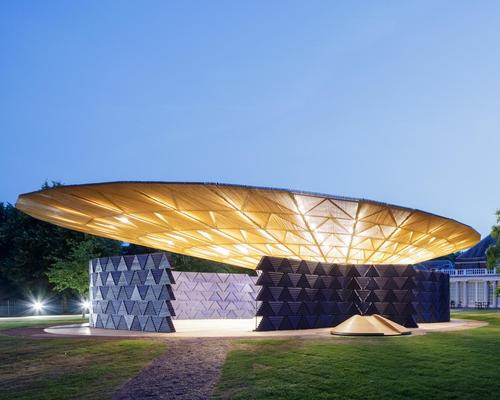18 Dec 2017
Serpentine Pavilion finds new home in Malaysia
BY Kim Megson

Diébédo Francis Kéré’s acclaimed 2017 Serpentine Pavilion – one of London’s architectural highlights this year – has found a new home in Malaysia.
The ILHAM Gallery in Kuala Lumpur has announced it has been able to acquire the popular pavilion “due to the generous donations by our philanthropic friends and supporters”.
The structure will be transported to Malaysia early next year, and ILHAM plans to eventually install it in a public space for the Malaysian public. Details of the exact location are yet to be revealed.
Conceived in 2000 by Serpentine Galleries in London, the annual pavilion has become an international site for architectural experimentation, with Frank Gehry, Zaha Hadid, Bjarke Ingels Group, Sou Fujimoto and Herzog & de Meuron with Ai Weiwei among those commissioned to design their own summertime temporary public structure for the Serpentine’s site in Kensington Gardens.
Kéré’s pavilion opened in June and was initially due to close on 9 October. However, due to popular demand, this was extended until 19 November.
Designed “to bring a sense of light and life” to the park, the structure was inspired by the tree that serves as a central meeting point for life in Kéré’s hometown of Gando, Burkina Faso.
To mimic the tree’s canopy, he visualised an expansive timber roof supported by a central latticed steel framework, which allows air to circulate freely while offering shelter against London rain and summer heat.
An oculus funnels rainwater collected on the roof to create a waterfall effect into an open courtyard below, which is set above a hidden underground storage tank.
There are four separate entry points into the pavilion, and the structure’s bright indigo walls – formed of inverted wooden triangles – are angled so as to let daylight flood in.
The architect told CLADglobal that he wanted to connect visitors to nature and each other and said that the project had given him an “exciting opportunity to explore new ideas, new ways of shaping space, new materials and a new way of using materials”.
“Well designed public spaces, where we can all meet and come together, are the foundation for a healthy society,” he added. “The value [such spaces] give to a community cannot be measured by money, which is why it’s very important to think how we can create more.”
Technical consultant David Glover, fabrication firm Stage One and engineers AECOM collaborated with Kéré’s team on the project.
The budget for the Serpentine’s annual architectural showcase is provided through sponsorship – coming from Goldman Sachs for the past three years – help-in-kind support and the eventual sale of the pavilions.
Of the past pavilions, Zaha Hadid’s from 2000 can be visited at Flambards Theme Park, Cornwall; Toyo Ito’s from 2002 in the grounds of Le Beauvallon private property in Sainte-Maxine, France; and Sou Fujimoto's from 2013 is on exhibition in Tirana, Albania. Smiljan Radic’s 2014 Pavilion, a semi-translucent, cylindrical structure, is now situated at Hauser & Wirth Somerset.
Ingels’ ‘zipped wall’ effort from 2016 is set to be rebuilt in Downtown Vancouver after being purchased by Canadian developer Westbank, while the four summer houses that were specially commissioned to surround that structure have been sold privately by specialist architectural estate agency Modern House.
The architect of the 2018 Serpentine Pavilion will be announced in February, with it once again set to be an individual or practice never to have built before in the UK.
Architects Richard Rogers and Sir David Adjaye will advise the Serpentine Galleries’ CEO Yana Peel and artistic director Hans Ulrich Obrist, who will decide who to commission.
Close Window